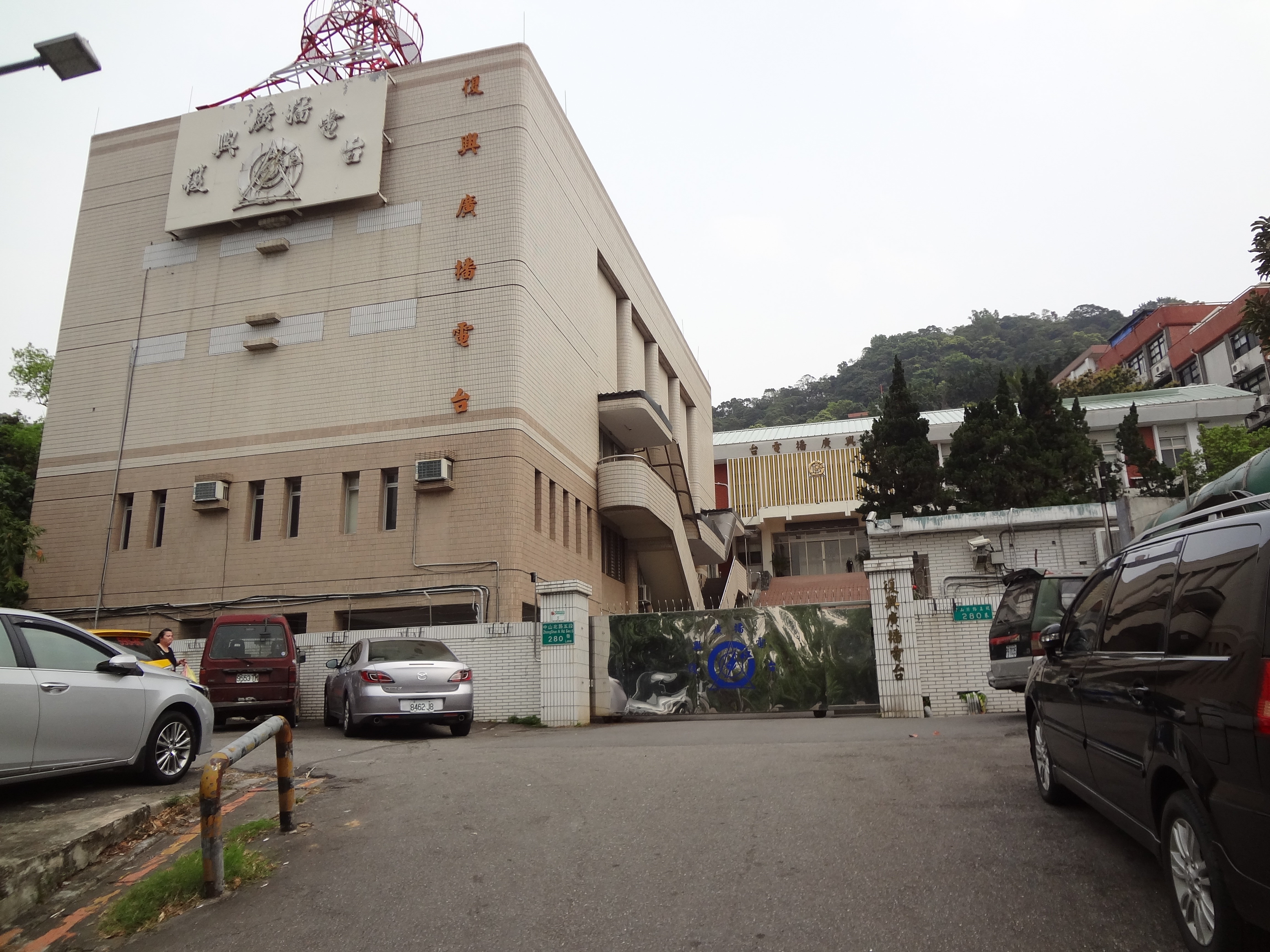|
Fu Hsing Broadcasting Station
Fu Hsing Broadcasting Station (FHBS; ) is a state-run radio station sponsored by Republic of China Armed Forces, located on the campus of Ming Chuan University in Taipei, Taiwan and is operated by the Ministry of National Defense. Its website is currently blocked in the People's Republic of China. History and overview Fu Hsing Broadcasting Station was founded on 1 August 1957, with units in Taipei, Taichung, and Kaohsiung. The station currently operates two radio networks. The first network acts as a "cross-strait" information service for domestic audiences. The second network and a shortwave network provides mainland Chinese audiences with propaganda about Taiwan and the Republic of China. Frequency Taipei * AM558, 909 kHz, the second radio network: AM594, 1089 kHz Taichung * FM107.8 MHz second radio network: AM594, 1089 kHz Kaohsiung * AM594 kHz, the second radio network: AM846 kHz Mainland China * HF Net: 9410, 9774, 15375 kHz See also *Med ... [...More Info...] [...Related Items...] OR: [Wikipedia] [Google] [Baidu] |
Fuxing Radio Tower Taipei , a county-level city of Fuzhou in Fujian Province, People's Republic of China
{{disambig ...
Fuxing may refer to: *Fu star (福星), or Fuxing, Chinese deity * Fuxing (train) (复兴号, meaning "Rejuvenation"), China Standardized EMU operated by China Railway High-speed (CRH) *Fuxing Road (other) *Chinese compound surname (複姓) Mainland China *Fuxing, Li County, in Li County, Hunan Taiwan *Fuxing, Changhua (福興鄉), township in Changhua County *Fuxing District, Taoyuan (復興區), aboriginal district in Taoyuan *Fuxing Islet (復興嶼), Lieyu Township, Kinmen County *Fuxing Radio (復興廣播電台), radio station in Taipei See also * Fucking (other) * Fuqing (; Foochow Romanized: Hók-chiăng; also romanized as Hokchia) is a county-level city of Fujian Province, China, it is under the administration of the prefecture-level city of Fuzhou. Geography Fuqing is located in the north-central part of ... [...More Info...] [...Related Items...] OR: [Wikipedia] [Google] [Baidu] |
Voice Of Han
Voice of Han Broadcasting Station () also known as Voice of Han Chinese Broadcasting Station was founded in 1942 by the Ministry of National Defense. It is headquartered on Xinyi Road in the Zhongzheng District of Taipei, Taiwan. History 1942, Voice of Han Radio was located in Mainland China and originally called Military Radio. 1949, the military radio station moved to Taiwan when the Kuomintang retreated following the Chinese Civil War. 1988, the military radio station was renamed to "Voice of Han" and launched more extensive coverage which offered listeners radio programs to listeners nationwide. 2002, on the 60th anniversary celebration of the radio station, President of the Republic of China, Chen Shui-bian broadcast a speech on Voice of Han calling for a communication bride between the two sides of the Taiwan Strait. 2010, Voice of Han Broadcasting in Kinmen added another frequency coverage, including Xiamen, which is located in Mainland China. Frequency FM *Northern: ... [...More Info...] [...Related Items...] OR: [Wikipedia] [Google] [Baidu] |
Public Broadcasting In Taiwan
In public relations and communication science, publics are groups of individual people, and the public (a.k.a. the general public) is the totality of such groupings. This is a different concept to the sociological concept of the ''Öffentlichkeit'' or public sphere. The concept of a public has also been defined in political science, psychology, marketing, and advertising. In public relations and communication science, it is one of the more ambiguous concepts in the field. Although it has definitions in the theory of the field that have been formulated from the early 20th century onwards, and suffered more recent years from being blurred, as a result of conflation of the idea of a public with the notions of audience, market segment, community, constituency, and stakeholder. Etymology and definitions The name "public" originates with the Latin '' publicus'' (also '' poplicus''), from ''populus'', to the English word 'populace', and in general denotes some mass population ("the p ... [...More Info...] [...Related Items...] OR: [Wikipedia] [Google] [Baidu] |
Mass Media In Taipei
Mass is an intrinsic property of a body. It was traditionally believed to be related to the quantity of matter in a physical body, until the discovery of the atom and particle physics. It was found that different atoms and different elementary particles, theoretically with the same amount of matter, have nonetheless different masses. Mass in modern physics has multiple definitions which are conceptually distinct, but physically equivalent. Mass can be experimentally defined as a measure of the body's inertia, meaning the resistance to acceleration (change of velocity) when a net force is applied. The object's mass also determines the strength of its gravitational attraction to other bodies. The SI base unit of mass is the kilogram (kg). In physics, mass is not the same as weight, even though mass is often determined by measuring the object's weight using a spring scale, rather than balance scale comparing it directly with known masses. An object on the Moon would weigh less t ... [...More Info...] [...Related Items...] OR: [Wikipedia] [Google] [Baidu] |
Radio Stations Established In 1956
Radio is the technology of signaling and communicating using radio waves. Radio waves are electromagnetic waves of frequency between 30 hertz (Hz) and 300 gigahertz (GHz). They are generated by an electronic device called a transmitter connected to an antenna which radiates the waves, and received by another antenna connected to a radio receiver. Radio is very widely used in modern technology, in radio communication, radar, radio navigation, remote control, remote sensing, and other applications. In radio communication, used in radio and television broadcasting, cell phones, two-way radios, wireless networking, and satellite communication, among numerous other uses, radio waves are used to carry information across space from a transmitter to a receiver, by modulating the radio signal (impressing an information signal on the radio wave by varying some aspect of the wave) in the transmitter. In radar, used to locate and track objects like aircraft, ships, spacecraft an ... [...More Info...] [...Related Items...] OR: [Wikipedia] [Google] [Baidu] |
Censorship In China
Censorship in the People's Republic of China (PRC) is implemented or mandated by the PRC's ruling party, the Chinese Communist Party (CCP). It is one of strictest censorship regimes in the world. The government censors content for mainly political reasons, such as curtailing political opposition, and censoring events unfavorable to the CCP, such as the 1989 Tiananmen Square protests and massacre, pro- democracy movements in China, the Uyghur genocide, human rights in Tibet, the Taiwan independence movement, Falun Gong, and pro-democracy protests in Hong Kong. Since Xi Jinping became the General Secretary of the Chinese Communist Party (''de facto'' paramount leader) in 2012, censorship has been "significantly stepped up". The government has censorship over all media capable of reaching a wide audience. This includes television, print media, radio, film, theater, text messaging, instant messaging, video games, literature, and the Internet. The Chinese government asserts that ... [...More Info...] [...Related Items...] OR: [Wikipedia] [Google] [Baidu] |
Radio Stations In Taiwan
The mass media in Taiwan is considered to be one of the freest and most competitive in Asia. Cable TV usage is high (around 80%) and there is also a wide selection of newspapers available covering most political viewpoints. Taiwan's media history While Taiwan's media freedom may rank among the top few nations in Asia today, its progress to its current state of vibrancy was not without a struggle. The Japanese occupation of Taiwan from 1895 to 1945 did not slow down the pace of economic modernisation on the island; the Kuomintang (KMT, Nationalist Party) also built on the successes of its predecessors to modernize and this provided the basis for its mass media industry to develop. However, KMT's pursuit of economic progress and democratic ideals did not automatically mean that Taiwan's media could fulfill its role as the fourth estate of democracy, as a check on the government. The martial law era media was kept on a tight leash and the explicit prohibition from enquiring about then ... [...More Info...] [...Related Items...] OR: [Wikipedia] [Google] [Baidu] |
Military Of The Republic Of China
The Republic of China Armed Forces (ROC Armed Forces) are the armed forces of the Republic of China (ROC), once based in mainland China and currently in its remaining jurisdictions which include the islands of Taiwan, Penghu, Kinmen, Matsu, and other smaller ROC-controlled islands such as Taiping Island in the South China Sea. They consist of the Army, Navy (including the Marine Corps), Air Force and Military Police Force. The military is under the civilian control of the Ministry of National Defense, a cabinet-level agency overseen by the Legislative Yuan. It was previously named the National Revolutionary Army (NRA) before being renamed as the Republic of China Armed Forces in 1947 due to the implementation of the newly promulgated Constitution of the Republic of China. It was also historically referred as the Chinese National Armed Forces (CNAF) prior to the establishment of the People's Republic of China on the Chinese mainland and the gradual loss of internatio ... [...More Info...] [...Related Items...] OR: [Wikipedia] [Google] [Baidu] |
Voice Of The Strait
Voice of the Strait (), Founded on August 24, 1958. the predecessor is the PLA Fujian Front Line Broadcasting Station (), established in Yuandang Street No. 15, Gulou District, Fuzhou city, Fujian province, People's Republic of China. is composed of People's Liberation Army opened stations, mainly for the Taiwan radio, broadcast radio the Mandarin and Minnan language dialect program, now has 5 broadcast channels, also set up Chinese classical network radio. The platform is provided with the official website of the network. The radio's wave power is very large; waves mainly cover Taiwan and East China, Asia, Europe, Africa, Oceania and America, and even the Arctic and Antarctic can also receive shortwave broadcasts belonging to the international radio. While the Mediumwave of power is very small, in the daytime distance near the launch site, almost can not receive. The interval signal is a bell rendition of " Three Rules of Discipline and Eight Points for Attention". In 20 ... [...More Info...] [...Related Items...] OR: [Wikipedia] [Google] [Baidu] |
China National Radio
China National Radio (CNR; ; pronunciation: ) is the national radio network of China, headquartered in Beijing. History The infrastructure began with a transmitter from Moscow to set up its first station in Yan'an (延安). It used the call sign XNCR ("New China Radio") for broadcasts, and is the first radio station set up by the Chinese Communist Party in 1940. Miller, Toby (2003). ''Television: Critical Concepts in Media and Cultural Studies''. Routledge Publishing. In the west, it was known as the Yan'an New China Radio Station () broadcasting two hours daily. In China, it was called the Yan'an Xinhua Broadcasting Station, which was established on 30 December 1940.CNR website.CNR website" ''CNR introduction.'' Retrieved on 2007-04-29. On 25 March 1949, it was renamed Shanbei Xinhua Broadcasting Station () after it departed from Yan'an. It began to broadcast in Peiping under the name of Peiping Xinhua Broadcasting Station (). On December5, 1949, it was officially name ... [...More Info...] [...Related Items...] OR: [Wikipedia] [Google] [Baidu] |
Cross-Strait War Of Propaganda
Cross-Strait propaganda () refers to campaigns made by the Republic of China on Taiwan and the People's Republic of China on the mainland. Many of these were aimed at turning military personnel against each other's regimes and encouraging them to defect. Such activities began after the end of the Chinese Civil War and did not stop until 1990. However, some creations of this era are still in use today, such as signs facing away from their country of origin. Both sides used megaphones and radio stations for broadcasting, and balloons and floating carriers for sending leaflets and other objects. Defectors came from both sides, bringing with them information and intelligence about their original regimes. Broadcasting stations See also * Propaganda in the People's Republic of China * Propaganda in the Republic of China ** Beishan Broadcasting Wall ** Mashan Broadcasting and Observation Station The Mashan Broadcasting and Observation Station () is a historical broadcasting st ... [...More Info...] [...Related Items...] OR: [Wikipedia] [Google] [Baidu] |





